What is a rebound in basketball?
The Basketball rebound: definition, technique and exercises
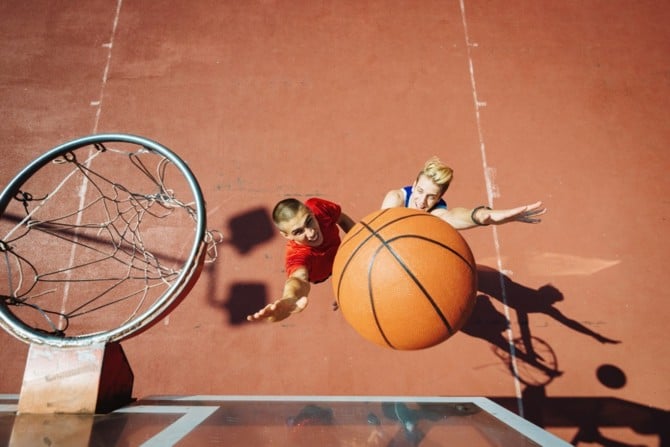
The missed shot is as much a part of basketball as the layup or even the legendary slam dunk. But what happens next? The rebound follows. In this article, we'll explain the difference between offensive and defensive rebounding, how to properly secure a rebound and how you can train rebounding both as a team and by yourself.
What is a rebound in basketball?
In basketball, a rebound is the ball that bounces back after an unsuccessful basket attempt. The player who subsequently catches the ball (rebounding) is awarded the rebound.
On average, teams hit less than half of their shots in basketball. Even the best teams in the NBA rarely manage a shooting rate better than 50 percent. Once the ball hits the rim of board, whoever catches it just grabbed a rebound.
You often hearing talk of an offensive or defensive rebound, which refers to which team secures the ball:
- If the offense grabs the ball, it's an offensive rebound. Despite a missed shot, the team now has another chance to score.
- If the defending team grabs it, they secured a defensive rebound.
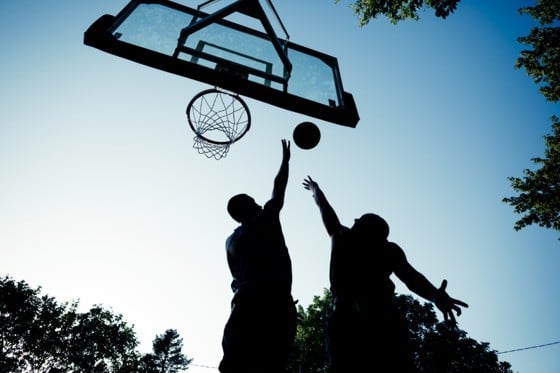
Worth knowing: The best rebounders of the 2020/21 NBA season secured between 12 and 15 rebounds per game, which makes Wilt Chamberlain's performance all the more impressive: In 1960, he even managed 55 rebounds in a single game. That remains a record to this day. Over his entire career, he also grabbed the most rebounds in NBA history with 23,924.
Rebound training: basics, technique and workouts
Size and jump height are very important for rebounding. However, those alone aren't enough to secure a rebound. The other aspect of a rebound in basketball comes down to technique. Let's first take a look at the basics for successful rebounding.
Rebound Basics
Only the interaction of different components enables you to regularly stand exactly where the ball lands and to reach it before your opponent. You should therefore train the following components specifically.
Jump height
Sure, the basket hangs at a height of 3.05 meters, and the ball flys upwards after a missed shot. The higher up you can get your hands on the leather, the better your chance of getting the rebound. Jump can compensate for a few missing centimeters.
Anticipation, experience and positional play
Not every ball bounces off the hoop in the same way and in the same direction. A three-pointer, for example, bounces further away than a shot from the centre distance. If the ball hits the hoop after a high trajectory, it will also bounce higher, but shorter, than if it hits at a shallower angle. It is therefore important that you learn how the ball behaves so that you can position yourself accordingly. On the one hand, theoretical analysis helps, on the other hand, experience and precise observation. Rebound specialist Dennis Rodman, for example, even studied the way the ball rotates and how it affects his rebounding behaviour.
In this video clip, Rodman himself explains how he practised rebounding:
Unboxing
Unboxing - the favourite of almost every coach. Size and bounce alone do not guarantee a rebound in basketball. Dennis Rodman (career average: around 13 rebounds per game), for example, is one of the best rebounders in NBA history at "only" a good six feet. He made up for a lack of body length with an incredible feel for the path of the ball after a missed shot. He also had a talent for keeping his opponent fairly away from the ball: boxing out.
By cleverly placing yourself between the opponent and the basket, you'll block your opponent's path to the ball. Although you bend your knees, you make sure that even taller players can't simply reach over you. Because by bending forward slightly, you put more distance between the opponent and the ball.
Willpower
Rebounding in basketball is work - and thus also serves as proof against the myth of basketball as a disembodied sport. Physicality dominates under the boards. If two players want to box out at the same time, friction occurs. There is a little pushing, but only within the rules. To hold your own there, even against bigger, stronger players, requires willpower.
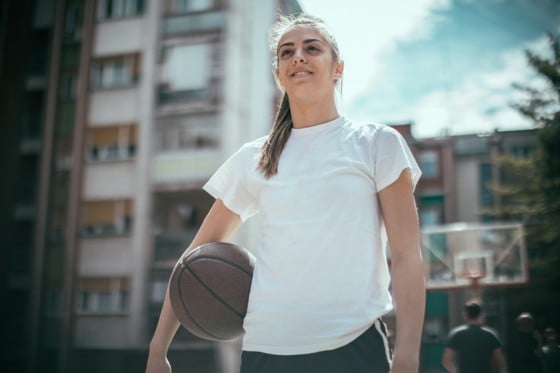
Timing
Jumping too early is no more helpful than still being on your knees when the ball has long since passed its highest point. Over time, you will develop a feeling for the right timing. So you jump off exactly when you can grab the rebound at the highest point for you personally. Because your own jumping abilities also play a central role.
Reactivity
No matter how well you anticipate, everything cannot be completely balanced in advance. Sometimes the ball hits the ring a few millimeters further down, so it bounces back toward the thrower instead of sliding straight forward. Other times, it claps back and forth inside the ring cylinder a few times, then falls toward the ground on one side. The faster you react in such cases, the higher the chance of the rebound.
Technique: 3 phases for a successful basketball rebound
Every rebound in basketball can be divided into three phases - and for each one, you can increase the chance of a successful rebound by keeping the following things in mind:
1st phase - the flight of the ball
The work for the rebound does not start when the ball reaches the ring. Instead, immediately after it leaves the thrower's fingertips, you anticipate at what angle it might hit the ring and where.Accordingly, you move towards your position.
For the necessary stability, bend your knees slightly and take your opponent on your back, so to speak, for boxing out. First make contact with his chest and only then turn towards the basket. You should not actively hold him back with your arms. This will quickly lead to a foul whistle. Instead, raise your hands above shoulder height to shorten the way up when the ball bounces off the ring. It is important that you never position yourself statically, but always on the ball of the forefoot to remain mobile at all times.
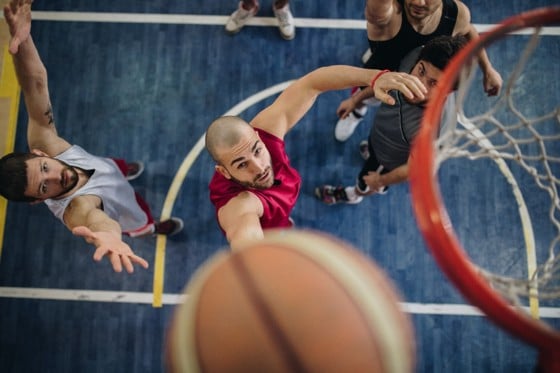
2nd phase - Rebounding the ball
If the ball bounces off the hoop, jump off at the right time. Aim to touch the ball with your hands at the highest point of your jump. To do this, raise both arms, as the two-handed basketball rebound makes it easier for you to secure the ball. You can reach a little higher if you first touch the ball with one hand and then with the other. Once you have secured the ball, pull it towards your chest while it is still in the air.
Phase 3 - sticking the landing
When landing, always make sure to bend your knees slightly and not to land stiffly. This protects the joints. To secure the ball after the rebound, spread your elbows outwards. However, do not swing them wildly back and forth. On the one hand, there is the danger of hitting the opponent in the head, and on the other hand, of committing a foul and having to give away the rebound you just secured.
Then turn into the next movement - in the case of a defensive rebound, either a pass to the build-up player or your own dribbling towards the opponent's basket; in the case of an offensive rebound, a quick lay-up directly in the hoop. Make sure you do not lift your supporting leg. Otherwise you will make a step mistake. It is best to use the star step, where you only move with your free foot, to find a good angle for the next action.
3 rebound exercises to improve your game
There are many aspects to rebounding. Technique, physicality and the mental aspect all play a role. At the same time, you can practice rebounding not only indidually but also as a team. Therefore, you can pick and choose the drill you need to improve your game.
Mental rebound training
Mental training has long had a footing in sports. Not only can it help with decision making but it can also increase your ability to concentrate. Both of these will definitely help with your basketball rebound. The more you can focus on the ball, its trajectory and the rebound angle, the better you can position yourself.
Rebound drills to do alone
Even by yourself, there are plenty of ways to train effectively.
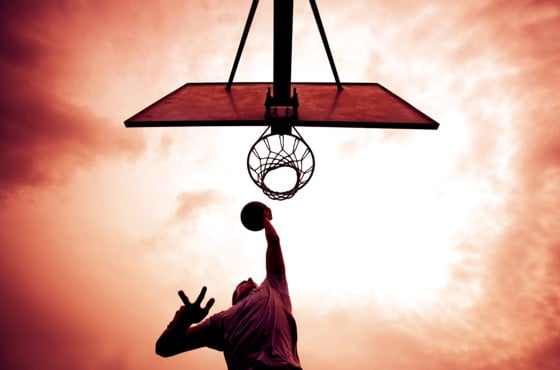
Off the wall single hand catch
As safe as it would be to grab the ball directly with both hands, it actually makes more sense to grab the ball with one hand at first when rebounding. If you stretch the left hand a little further upwards, this allows a higher jump. As soon as you have one hand on the ball, immediately pull the other one up. This way you can reach for the ball at a higher point to secure it as quickly as possible afterwards.
You can practise this rebounding technique by throwing the basketball high against the wall of the house. From the rebounding position, jump up and grab it with one hand.
Off the Wall Catch & Turn
The faster you turn after the rebound, the faster you can initiate the counter-attack, the fastbreak. To practise this turn, throw the basketball against the wall of the house as well. Instead of just jumping up and landing, you already turn in the air towards the imaginary other basket. A quarter turn is also enough to start with. Approach slowly and try it in both directions.
Off the Wall Moving Catch
Since the ball does not always bounce off the ring in the same way, do not always just stand directly in front of the wall. Try different angles and distances to prepare for rebounds that bounce different distances.
Reactive Bounce Catch
A quick second or even third jump increases the chance of the rebound. Often, the ball does bounce directly form the rim to your hands. Zion Williamson, for example, is particularly good at this skill and often beats the opponent to the ball. To practise this movement, first hold the basketball in both hands. Now jump and slam the ball to the ground at the highest point of your jump. Once landed, jump off again to secure the rebound.
Wall Box Out Bounce & Catch
Boxing out your opponents is a great option to help secure a rebound. However, make sure you don't push anyone - otherwise you'll draw a foul. Instead, use your arms like a shield to keep the opponents at a distance. You can even practise this at home. Start by resting your forearm against the wall. With the other hand, bounce the basketball on the floor with pressure and then grab the rebound.
Recommended: Also read up on basketball drills you can do at home.
Basketball rebound drills as a team
Both the ball and the opponents are constantly moving. Communication and coordination are essential in basketball to win. This also applies to rebounding. Therefore, it's a good idea to do some rebounding exercises as a team.
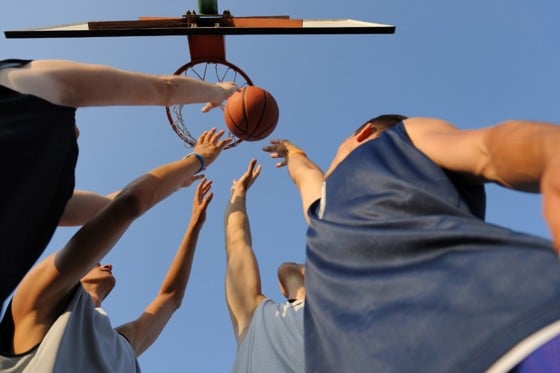
Rotation-Rebounding
Three or four offensive and three or four defensive players each run around the zone. The offense runs clockwise while the defense runs counterclockwise. As soon as the coach throws the ball, each defender looks for an offensive player to block out. Only then does the fight for the rebound begin. If the offensive team grabs the ball, it tries to score. If the defending team gets the rebound, they play to the opposite basket.
Slide Rebounding
Spacing - i.e. spreading the field by several distance shooters - against rebounding: The offence places itself around the three-point line, the defence lined up centrally in the zone between the baseline and the free-throw line. There, the defending players move from left to right and back again within the zone until the coach passes the ball to an offensive player and calls the name of a defender. The defender sprints towards the player with the ball, while his teammates have to find an offensive player to box out. It is important to communicate in such a way that everyone reaches an opponent as quickly as possible. After that, it is up to the defending team to secure the rebound.
Golden Egg
In four pairs, the offense and defense places themselves around the circle at the free-throw line, with the defenders standing further inside. A basketball is placed in the middle. When called by the coach, the offensive players try to grab the ball by fair means, while the defenders do everything they can to stop them by boxing them out. If no offensive player has a hand on the basketball for five seconds, the defense has won and the next round is on. After a few rounds, you can switch roles.
To keep fit outside of basketball training, the best way to do this is to try indoors.
Basketball rebound: definition and training tips
Crucial basics, the right technique, forms of training for you alone and in a team - now you have everything you need to improve your rebounding in basketball. And to either use it to defend your own basket and get your offence going or to score quickly in attack after a missed shot by your team-mate. Possibly even with a dunk.
Our tips on basketball attack and defence strategies will teach you the best way to set up your offense and defense Make sure you look the part with our customized basketball jerseys.
Image Credits: Title Image: Drazen_/gettyimages; Image 2: NoSystem images/gettyimages; Image 3: South_agency/gettyimages; Image 4: gremlin /gettyimages; Image 5: technotr/gettyimages